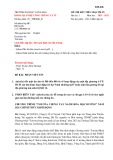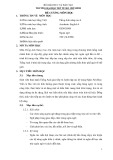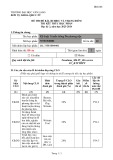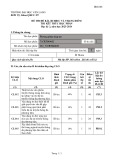
1
No. 79 (2024) 1-9 I jdi.uef.edu.vn
Journal of Development and Integration, No. 79 (2024)
Corresponding author. Email: sangtm@uef.edu.vn
https://doi.org/10.61602/jdi.2024.79.01
Received: 08-May-24; Revised: 04-Aug-24; Accepted: 10-Aug-24; Online: 01-Nov-24
ISSN (print): 1859-428X, ISSN (online): 2815-6234
K E Y W O R D S A B S T R A C T
Brand switching
intention,
Commitment,
Post-purchased
student regret,
Service dominant,
Tuition.
Post-purchased student regret and brand-switching intention have recently become a
vital issue for most universities, especially the financially autonomic ones. There is fierce
competition among universities with the vital aim to attract and keep students with them.
Thus, the paper aims to search out “The mediating role of student-post purchase regret
in university brand switching intention”. Quantitative research was conducted with a
non-probability sample. The data was collected from six-hundred university students in
three financial autonomy Vietnamese universities and was processed by SmartPLS 4.0
software. Research results show that service-dominant has a negative effect on student’s
post-purchase regret and perceived commitment is negatively correlated to student’s post-
purchase regret. In addition, tuition unfairness also negatively impacts students’ post-
purchase regret. On the contrary, students’ post-purchase regret is positively correlated
to university switching intention. The findings also indicate that students’ post-purchase
regret plays a mediating role between all independent and dependent variables. The
findings help educational policymakers or managers interfere timely with the current
situation of their university and they can change or adjust their development-oriented
strategies rightly to be appropriate for the current competitive situation.
Ly Dan Thanh, Tang My Sang*
Ho Chi Minh City University of Economics and Finance, Vietnam
The mediating role of student-post purchase regret
in brand switching intention
1. Introduction
In the academic context, students’ switching in-
tention has become a vital issue for most universi-
ties, especially in Vietnam due to the current open
enrollment methods. This makes more opportunities
for the approach of learning at universities easier for
high school students to reach their university dream.
The more chances for high school students, the more
challenges for academic educators.
From the perspective of learning, students have
a total right to decide which university to ensure
their future learning and they also may cease the
relationship if they no longer expect it. Therefore,
it makes fierce competition among universities
to attract and keep students studying until their
graduation (Roelofs & Nieuwenhuis, 2016).
Most researchers claim that there is an inmate
relationship between regret and brand-switching
intention (Salimi et al., 2022). However, finding out






























